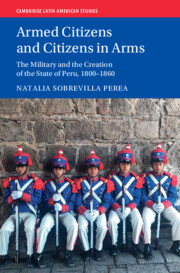Refine search
Actions for selected content:
231 results
Ballast: Approaching nineteenth-century maritime mobility ‘from below’
-
- Journal:
- Journal of Global History , First View
- Published online by Cambridge University Press:
- 26 December 2025, pp. 1-19
-
- Article
-
- You have access
- Open access
- HTML
- Export citation
Gauging the Black Undercount: Race and Censuses in Nineteenth-Century Buenos Aires
-
- Journal:
- Social Science History , First View
- Published online by Cambridge University Press:
- 09 December 2025, pp. 1-31
-
- Article
-
- You have access
- Open access
- HTML
- Export citation
Migration networks in the configuration of mining communities in Spain in the nineteenth century: Linares
-
- Journal:
- Revista de Historia Economica - Journal of Iberian and Latin American Economic History , First View
- Published online by Cambridge University Press:
- 01 December 2025, pp. 1-31
-
- Article
-
- You have access
- Open access
- HTML
- Export citation
Archives
-
- Book:
- The Archives and Afterlives of Nautch Dancers in India
- Published online:
- 24 October 2025
- Print publication:
- 13 November 2025, pp 1-24
-
- Chapter
- Export citation
1 - Nautch in Colonial Human Exhibits, and the (Im)Possibility of Dance Reenactments
-
- Book:
- The Archives and Afterlives of Nautch Dancers in India
- Published online:
- 24 October 2025
- Print publication:
- 13 November 2025, pp 25-54
-
- Chapter
- Export citation
2 - Insurgent Gestures
-
- Book:
- The Archives and Afterlives of Nautch Dancers in India
- Published online:
- 24 October 2025
- Print publication:
- 13 November 2025, pp 55-87
-
- Chapter
- Export citation
3 - Sundaris and Jans in the Age of Mechanical Reprodarshan
-
- Book:
- The Archives and Afterlives of Nautch Dancers in India
- Published online:
- 24 October 2025
- Print publication:
- 13 November 2025, pp 88-133
-
- Chapter
- Export citation

Louise Farrenc: Nonet for Winds and Strings
-
- Published online:
- 23 October 2025
- Print publication:
- 23 October 2025
7 - Reception and Legacy
-
- Book:
- Donizetti: Lucia di Lammermoor
- Published online:
- 06 November 2025
- Print publication:
- 23 October 2025, pp 156-176
-
- Chapter
- Export citation
17 - Public Music Education and the Prague Conservatory
- from Part II - The “Long” Nineteenth Century
-
-
- Book:
- A History of Music in the Czech Lands
- Published online:
- 21 October 2025
- Print publication:
- 16 October 2025, pp 240-252
-
- Chapter
- Export citation
“Slavery-Free”: Labour at the Todos os Santos Factory (Bahia, ca. 1840–1870)
-
- Journal:
- Itinerario / Volume 49 / Issue 2 / August 2025
- Published online by Cambridge University Press:
- 24 September 2025, pp. 336-356
-
- Article
-
- You have access
- Open access
- HTML
- Export citation

Armed Citizens and Citizens in Arms
- The Military and the Creation of the State of Peru, 1800‒1860
-
- Published online:
- 12 September 2025
- Print publication:
- 25 September 2025
A Genre in Flux: Grand opéra Through the Lens of French Touring Companies, 1830–1860
-
- Journal:
- Cambridge Opera Journal / Volume 37 / Issue 2 / July 2025
- Published online by Cambridge University Press:
- 01 September 2025, pp. 102-125
-
- Article
-
- You have access
- Open access
- HTML
- Export citation
5 - Individual Rights under International Law
-
- Book:
- People v. The Court
- Published online:
- 07 August 2025
- Print publication:
- 21 August 2025, pp 113-134
-
- Chapter
- Export citation
From Past to Future
-
- Book:
- Democracy's Double Helix
- Published online:
- 09 September 2025
- Print publication:
- 14 August 2025, pp 288-306
-
- Chapter
- Export citation
Introduction
-
- Book:
- The Birth of Democracy in South America
- Published online:
- 04 June 2025
- Print publication:
- 07 August 2025, pp 1-16
-
- Chapter
-
- You have access
- Open access
- HTML
- Export citation
2 - Elections and Democracy in South America before 1930
-
- Book:
- The Birth of Democracy in South America
- Published online:
- 04 June 2025
- Print publication:
- 07 August 2025, pp 48-73
-
- Chapter
-
- You have access
- Open access
- HTML
- Export citation
4 - The Origins of Strong Parties in South America
-
- Book:
- The Birth of Democracy in South America
- Published online:
- 04 June 2025
- Print publication:
- 07 August 2025, pp 98-122
-
- Chapter
-
- You have access
- Open access
- HTML
- Export citation
5 - The Roots of Strong Democracies
-
- Book:
- The Birth of Democracy in South America
- Published online:
- 04 June 2025
- Print publication:
- 07 August 2025, pp 123-174
-
- Chapter
-
- You have access
- Open access
- HTML
- Export citation
1 - Armies, Parties, and the Birth of Democracy
-
- Book:
- The Birth of Democracy in South America
- Published online:
- 04 June 2025
- Print publication:
- 07 August 2025, pp 17-47
-
- Chapter
-
- You have access
- Open access
- HTML
- Export citation
